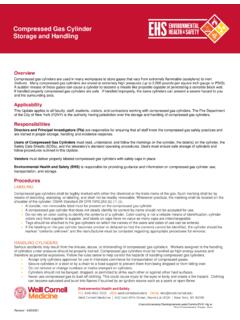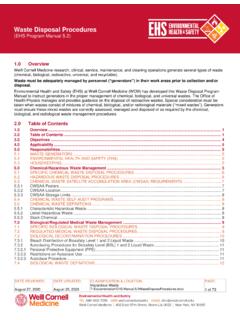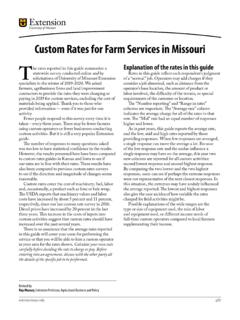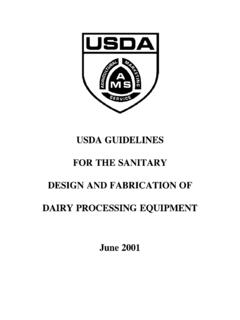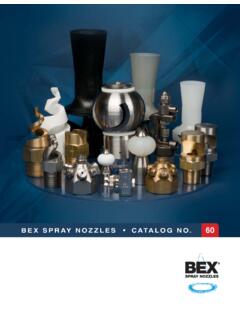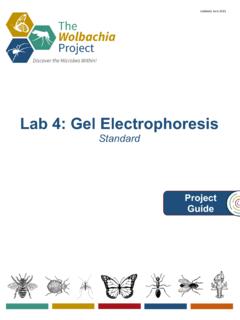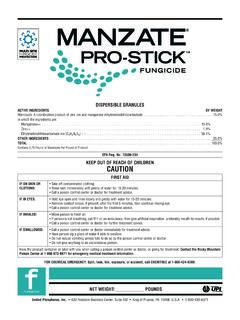Transcription of Bloodborne Pathogens Exposure Control Plan
1 DATE REVIEWED: October 15, 2020 DATE UPDATED: October 05, 2020 CLASSIFICATION & LOCATION: Lab Safety, Clinical Safety T:\Documentation\EHS-Manual\ PAGE: 1 of 30 Bloodborne Pathogens Exposure Control plan (EHS Program Manual ) Overview This Bloodborne Pathogens Exposure Control plan (ECP) has been developed as part of the Weill Cornell Medicine (WCM) Environmental Health and Safety (EHS) Program Manuals. The Occupational Safety and Health Administration (OSHA) implemented the regulation, Occupational Exposure to Bloodborne Pathogens , contained in rule 29 Part of the Code of Federal Regulations (CFR); to help protect workers from the health hazards associated with occupational Exposure to pathogenic organisms present in blood and other body fluids.
2 This regulation aims to minimize or prevent the transmission of Bloodborne diseases including, but not limited to, Human Immunodeficiency Virus (HIV), Hepatitis B Virus (HBV) and Hepatitis C Virus (HCV). Table of Contents Overview .. 1 Table of Contents .. 1 Objective .. 2 Applicability .. 2 Responsibilities .. 2 ENVIRONMENTAL HEALTH AND SAFETY (EHS) .. 2 INSTITUTIONAL BIOSAFETY OFFICER .. 2 DEPARTMENTS / ADMINISTRATIVE UNITS .. 3 FACULTY, STAFF, & STUDENTS .. 3 Bloodborne Pathogen Exposure Control plan Procedures .. 3 OCCUPATIONAL Exposure DETERMINATION .. 3 ROUTINE OCCUPATIONAL Exposure .. 3 POSSIBLE OCCUPATIONAL Exposure .. 3 RARE OCCUPATIONAL Exposure .. 3 TASKS AND 4 Universal 5 Engineering Controls.
3 5 SHARPS CONTAINER ENGINEERING CONTROLS .. 5 BIOLOGICAL SAFETY CABINET ENGINEERING CONTROLS .. 5 Standard Work Practices .. 5 HAND WASHING .. 6 NEEDLES & SHARPS .. 6 EATING AND DRINKING .. 6 FOOD STORAGE .. 6 PIPETTING .. 6 SPLASH / SPRAY 6 SPECIMEN HANDLING .. 6 SERVICING / SHIPPING equipment .. 7 Personal Protective equipment .. 7 PROVISION, USE, & ACCESSIBILITY .. 7 7 MASKS, EYE PROTECTION, & FACE 8 PROTECTIVE CLOTHING .. 8 CLEANING, LAUNDERING, & DISPOSAL .. 8 REMOVAL / REPAIR / REPLACEMENT .. 8 Decontamination .. 8 DECONTAMINATION PROCEDURES .. 8 Waste Disposal .. 9 DATE REVIEWED: October 15, 2020 DATE UPDATED: October 05, 2020 CLASSIFICATION & LOCATION: Lab Safety, Clinical Safety T:\Documentation\EHS-Manual\ PAGE: 2 of 30 CONTINUED: Bloodborne Pathogens Exposure Control plan CONTAMINATED WASTE REMOVAL/DISPOSAL.
4 9 BIOLOGICALLY CONTAMINATED 9 SHARPS 9 HIV, HBV, & HCV Research Laboratory Work 9 Other Bloodborne Pathogens in Research Laboratories .. 10 Hepatitis B Vaccination .. 10 Accidental Exposures .. 11 MANAGEMENT OF NEEDLESTICK & BODILY FLUID 11 Immediate Instructions to Healthcare Worker at Time & Site of Injury .. 11 Immediate Instructions to All Other WMC 11 POST- Exposure EVALUATION & FOLLOW-UP .. 12 Hazard Communication .. 13 LABELS & SIGNS .. 13 RED BAGS .. 13 EXEMPTIONS .. 13 Training .. 13 Record Retention, Availability, & Revisions .. 14 MEDICAL RECORDS .. 14 ACCIDENT / INCIDENT INVESTIGATION RECORDS .. 14 TRAINING RECORDS .. 14 ANNUAL & PERIODIC REVIEW .. 14 Definitions .. 14 References.
5 16 Appendix A - OSHA CFR Title 29, Part - Bloodborne Pathogens Standard .. 17 Objective This Exposure Control plan (ECP) has been developed to minimize or eliminate employee occupational Exposure . Occupational Exposure is any "reasonably anticipated skin, eye, mucous membrane or parenteral contact with blood or other potentially infectious materials that may result from the performance of any employee's duties" without regard to the use of personal protective equipment . Sources of potentially infected material for the purposes of this ECP include humans and closely-related primates. Applicability This Bloodborne Pathogens Exposure Control plan applies to all WCM faculty, staff, and students whose work may involve the possible Exposure to human blood or other potentially infectious material(s), as well as other unfixed tissue specimens.
6 Activities by WCM faculty, staff, and students involving patient contact may additionally be governed by the NewYork-Presbyterian Hospital s Exposure Control plan . This ECP applies to the Hepatitis B Virus (HBV), a causative agent of infectious hepatitis, Hepatitis C Virus (HCV), Human Immunodeficiency Virus (HIV), the causative agent of Acquired Immune Deficiency Syndrome (AIDS), and other Bloodborne diseases. Responsibilities ENVIRONMENTAL HEALTH AND SAFETY (EHS) Writes, updates and enforces the rules and regulations contained in this ECP. Distributes this ECP to all WCM departments and administrative units. Provides appropriate Bloodborne Pathogens Exposure Control Training to all WCM faculty, staff, and students who may be occupationally exposed.
7 INSTITUTIONAL BIOSAFETY OFFICER Provides technical guidance and assists in the implementation of the ECP. Conducts inspections to ensure that all WCM areas are following appropriate Exposure prevention procedures. DATE REVIEWED: October 15, 2020 DATE UPDATED: October 05, 2020 CLASSIFICATION & LOCATION: Lab Safety, Clinical Safety T:\Documentation\EHS-Manual\ PAGE: 3 of 30 CONTINUED: Bloodborne Pathogens Exposure Control plan DEPARTMENTS / ADMINISTRATIVE UNITS Implement all rules and regulations discussed in this manual. Develop site-specific policies and procedures to supplement this general ECP as needed. Ensure that all staff receives the appropriate Bloodborne Pathogens Exposure Control training. FACULTY, STAFF, & STUDENTS Attend Bloodborne Pathogens Exposure Control training upon beginning employment at WCM, and annual refresher courses thereafter.
8 Follow all rules and regulations as outlined in this ECP. Bloodborne Pathogen Exposure Control plan Procedures OCCUPATIONAL Exposure DETERMINATION The potential for occupational Exposure to Bloodborne Pathogens has been assessed for all WCM employees; and was made without regard to the use of personal protective equipment , as required by the regulations. While some employees routinely face occupational Exposure , others may have the risk of possible Exposure periodically or rarely. Each Department has the duty to identify specific positions that fall within these categories. A list of general job duties that may lead to occupational Exposure is described in Section ROUTINE OCCUPATIONAL Exposure All employees in the job classifications listed below are considered to have routine occupational Exposure : Pathologists Pathology Assistants Dieners Phlebotomists POSSIBLE OCCUPATIONAL Exposure Some employees in the job classifications listed below are considered to be at reasonable risk of contact with blood and other potentially infectious materials (OPIM).
9 Faculty Physicians Physician Assistants/Surgical Assistants Nurses (except for administrative nurses) Research Fellows Research Associates Research Specialists Senior Research Technicians Research Technicians Laboratory Aides Maintenance Workers Building Service Workers Housekeepers Students with patient care responsibilities RARE OCCUPATIONAL Exposure Some employees in the job classifications listed below have rare occupational Exposure . Social Workers/Case Managers/Counselors Patient Representatives DATE REVIEWED: October 15, 2020 DATE UPDATED: October 05, 2020 CLASSIFICATION & LOCATION: Lab Safety, Clinical Safety T:\Documentation\EHS-Manual\ PAGE: 4 of 30 CONTINUED: Bloodborne Pathogens Exposure Control plan Telecommunications Facilities Supervisors Human Resources Medical Records Staff Pharmacy Staff Housing Director and Staff TASKS AND PROCEDURES The following functions and procedures cause an Occupation Exposure to the personnel conducting them when employing human blood or other potentially infectious material.
10 Tissue culture procedures Histological/cytological procedures (unfixed tissues) Collection of blood and other body fluids (specimens) and tissues Transportation of specimens to laboratory areas Preparation of blood and other body fluids and tissue specimens for assay or storage Phlebotomy Patient Care Activities: Direct patient care contact, including emergency first aid Assisting or performing diagnostic or therapeutic patient care procedures Assisting in surgical procedures Assisting in routine personal care activities Handling of Human Blood, Body Fluids or Tissue: Collecting body fluid or tissue specimens Transporting body fluid or tissue specimens Operating laboratory equipment used in blood, blood derivative or other body fluid testing Performing qualitative and quantitative tests and examinations of body fluid or tissue specimens Disposal or storage of body fluid or tissue specimens Cleaning of Patient Care Areas or Laboratory Areas and equipment .

